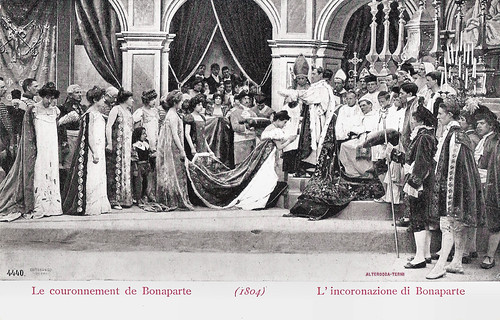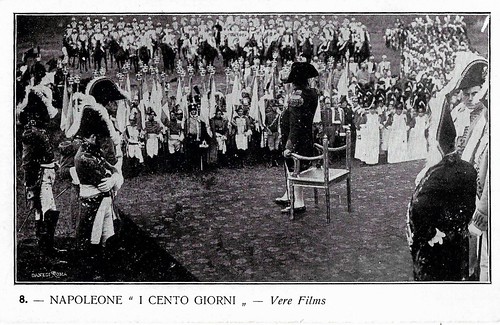Two centuries later, the cause of his death remains an unresolved mystery and his career and life continue to bitterly divide. He came to power by defeating right-wing opponents, with the ambition to reform France and place it at the heart of a unified Europe. He was autocratic and supported the restoration of slavery, but we also inherited his great administrative reorganisation. His Napoleonic Code defined civil law across large parts of the world, he introduced higher education, tax, road, and sewer systems and he set up the Banque de France.
Since 1906, some 60 films have been made about Napoleon. EFSP presents ou favourite Napoleon film postcards.

French postcard by Editions Cinémagazine, no.. 469. Albert Dieudonné as Napoleón in Napoléon (Abel Gance, 1927).

Italian postcard by Alterocca, Terni, no. 4444. Photo: Cinématographe Pathé. Photo: publicity still for L'Epopée napoléonienne/Napoleon Bonaparte (Lucien Nonguet, 1903). Caption: Waterloo (18 juin 1815).

French postcard by PC, no. 4157. Photo: Pathé Frères. Maximilien Charlier as Napoléon Bonaparte in the French silent film Napoléon 1er/Napoléon (N.N., 1909). Caption: Napoléon 1er. Austerlitz. The film was in two parts.

German postcard by Ross Verlag, no. 115/1. Photo: D.L.S. (Deutsche Licht-Spiele). Werner Krauss in Napoleon auf St. Helena/Napoleon at St. Helena (Lupu Pick, 1929).

German postcard by Ross Verlag, no. A 1352/1, 1937-1938. Photo: Metro-Goldwyn-Mayer. Charles Boyer in Conquest (Clarence Brown, 1937).

Belgian postcard, no. 348. Photo: Marlon Brando and Jean Simmons in Désirée (Henry Koster, 1954).
One of the greatest military strategists in history
The Corsica-born Napoleon was one of the greatest military strategists in history. Young, well-read, and highly intelligent, he rapidly rose in the ranks of the French Revolutionary Army during the late 1790s.
By 1799, France was at war with most of Europe, and Napoleon returned home from his Egyptian campaign to take over the reins of the French government and save his nation from collapse. After becoming the first consul in February 1800, he reorganised his armies and defeated Austria.
In 1802, he established the Napoleonic Code, a new system of French law, and in 1804 was crowned emperor of France in Notre Dame Cathedral. By 1807, Napoleon controlled an empire that stretched from the River Elbe in the north, down through Italy in the south, and from the Pyrenees to the Dalmatian coast.
Beginning in 1812, Napoleon began to encounter the first significant defeats of his military career, suffering through a disastrous invasion of Russia, losing Spain to the Duke of Wellington in the Peninsula War, and enduring total defeat against an allied force by 1814.
Exiled to the island of Elba, he escaped to France in early 1815 and raised a new Grand Army that enjoyed temporary success before its crushing defeat at Waterloo against an allied force under Wellington on June 18, 1815.
Napoleon was subsequently exiled to the island of Saint Helena off the coast of Africa. Six years later, he died, most likely of stomach cancer, and in 1840 his body was returned to Paris, where it was interred in the Hotel des Invalides.

Italian postcard by Alterocca, Terni, no. 4440. Photo: Cinématographe Pathé. Photo: publicity still for L'Epopée napoléonienne (Lucien Nonguet, 1903). Caption: Le Couronnement de Bonaparte (1804).

Big photo card by Cinéma Pathé. Photo: SCAGL / SAPF. Publicity still for Bonaparte et Pichegru (Georges Denola, 1911). Georges Saillard as Bonaparte and Louis Ravet as Pichegru. Script by Georges Mitchell.

Italian postcard by Danesi, Roma, no. 8 of a series of 24. Photo: Vere Films. Ettore Mazzanti in I cento giorni di Napoleone/The Hundred Days of Napoleon (Roberto Danesi, Archita Valente, 1914). 'The Hundred Days' marked the period between Napoleon Bonaparte's return from exile on the island of Elba to Paris on 20 March 1815 and the second restoration of King Louis XVIII on 8 July 1815 (a period of 110 days).

French postcard by FA, no. 312. Photo: Henri Manuel. Jean Worms, Comédie Française. Worms dressed up in Napoleonic costume.

French postcard in the Nos artistes dans leur loge series, no. 121. Photo: Comoedia, Paris. Boucot.

German postcard by Verlag Ross, Berlin, no. 536/1, 1919-1924. Egon von Hagen as Napoleon Bonaparte in So sind die Männer/The Little Napoleon (Georg Jacoby, 1923).

Italian postcard, no. 139. Photo: Films Paramount Roma. Gloria Swanson and Émile Drain in Madame Sans-Gêne (Léonce Perret, 1924). Collection: Didier Hanson.
A self-made hero and the embodiment of French national greatness
One of the most famous films about the French general is the French epic silent film Napoléon, vu par Abel Gance/Napoléon (Abel Gance, 1927), which recounted the life of Napoléon Bonaparte, tracing his early years through his invasion of Italy in 1796.
Abel Gance began his film as the first of a planned series of six films to cover the full life of the French emperor, but no subsequent films came to fruition. Gance presents Napoleon as a self-made hero and the embodiment of French national greatness.
The film begins with Napoléon as a child at the military college at Brienne where, as a sign of his future military genius, he leads his classmates to victory in a snowball fight.
As an adult, Napoléon (played by Albert Dieudonné) is imprisoned by the revolutionary leader Robespierre (Edmond Van Daële) during the Reign of Terror. After Robespierre’s fall in 1794, Napoléon is released from prison and subsequently marries the beautiful widow Joséphine (Gina Manès) and is appointed the commander of the French army in Italy.
Critics regularly hail Stanley Kubrick's Napoleon as the greatest and most tantalising unfinished film of all. Tragically, the studio that had financed 2001: A Space Odyssey wasn’t persuaded. A plan, schedule, and budget were delivered, but MGM did not proceed to the next stage.
Metro-Goldwyn-Meyer had just changed hands, and its new owners were more intent on building casinos than on funding monumental historical dramas with 50,000 military extras. Meanwhile, the arrival of Dino De Laurentiis’s own Napoleonic epic, Waterloo (1970), offered no encouragement. Many great actors interpreted Napoleon Bonaparte, including Charles Vanel in Königin Luise/Queen Luise (Karl Grune, 1927), Werner Krauss in Napoleon auf St. Helena/Napoleon at St. Helena (Lupu Pick, 1929), Charles Boyer in Conquest (Clarence Brown, 1937), Marion Brando in Desiree (Henry Koster, 1954), Rod Steiger in Waterloo (Sergei Bondarchuk, 1970) and Joaquin Phoenix in the upcoming Napoleon (Ridley Scott, 2022).

French postcard by Cinémagazine-Edition, no. 456. Photo: Vladimir Roudenko as the young Napoléon in Napoléon (Abel Gance, 1927).

French postcard by Editions Cinémagazines. Gina Manès as Josephine de Beauharnais in Napoléon (Abel Gance, 1927).

German postcard by Ross Verlag, no. 84/1, 1925-1935. Photo: Ufa. Albert Dieudonné as Napoléon in Napoléon (Abel Gance, 1927).

German postcard by Ross Verlag, no. 89/5. Photo: Terra Film. Mady Christians as Queen Louise of Prussia and Charles Vanel as Napoleon Bonaparte in the German silent film Königin Luise/Queen Luise (Karl Grune, 1927).

French postcard by J.R.P.R., Paris, no. 93. Émile Drain as Napoleon in Madame Récamier (Tony Lekain, Gaston Ravel, 1928).

German postcard by Ross Verlag, no. 115/2. Photo: D.L.S. Werner Krauss in Napoleon auf St. Helena/Napoleon at St. Helena (Lupu Pick, 1929). The outfit of Krauss is that of Goethe in the famous painting 'Goethe in the Campagna' (1787) by Tischbein.

British postcard in the Picturegoer Series, London, no. 962b. Photo: Metro-Goldwyn-Mayer. Charles Boyer in Conquest (Clarence Brown, 1937).

French postcard by Edit. Chantal, Rueil, no. 20. Photo: C.C.F.C. Jean-Louis Barrault as Napoléon Bonaparte in Le Destin fabuleux de Désirée Clary/Mlle. Desiree (Sacha Guitry, 1942).

Spanish postcard, no. 2656. Marlon Brando as Napoleon Bonaparte in Désirée (Henry Koster, 1954).
Sources: Kim Willsher (The Guardian), History.com, Britannica,
No comments:
Post a Comment